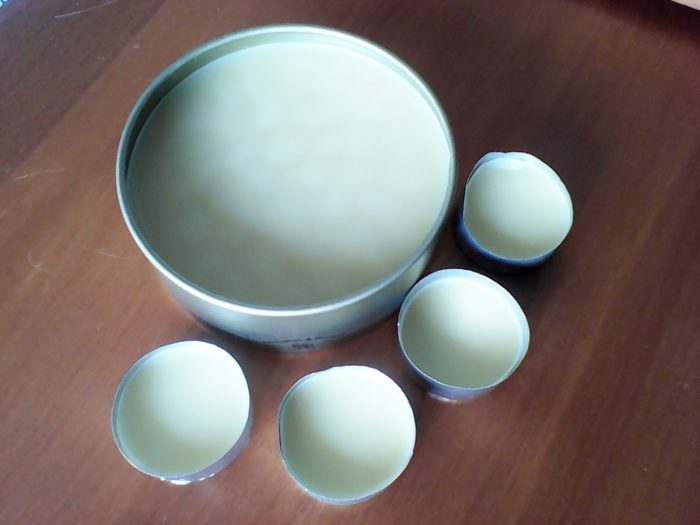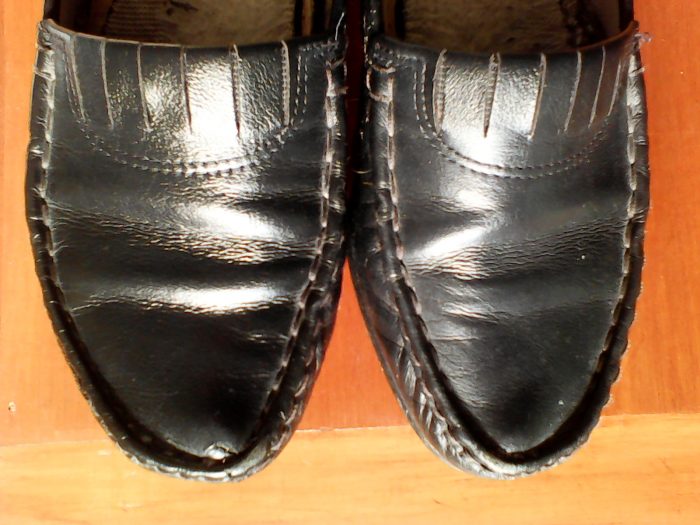Shoe polish, that is. You cannot make a Polish person. (Unless you are a Polish mummy and daddy, in which case, allow me to offer my congratulations. Gratulacje!)
This isn’t just shoe polish, however. This wonder-stuff can also be used as furniture polish, fabric waterproofer, or even lip balm. Simple homemade multipurpose thingummy? Lead me to it!
The recipe – if such it can be called – is found here. It’s a flexible guide to a) what ingredients to use and b) what to do with them. Wanting a beeswax-rich polish, I decided on a 1 – 1/2 – 1/2 blend, i.e. one part liquid (sweet almond oil) to half a part semi-solid (coconut oil) and half a part solid (beeswax).
I promptly messed the plan up by putting 1 part of beeswax in the double boiler (no pyrex jugs and aluminium plates here) alongside half a part of coconut oil. Mendable, mercifully, as I hadn’t started the melting yet. I fished out one of the large chunks of beeswax (leaving one behind) and doubled the sweet almond oil.
So it was something like 50g beeswax, 50mL coconut oil and 100mL sweet almond oil. Precision is not crucial (phew). Plus a bit of orange oil and cypress oil for a pleasant scent (since I discovered we were out of clove oil).
The coconut oil melted remarkably quickly, leaving the beeswax sulking in what looked like a pool of rather viscous water. I was starting to think that the beeswax did not mean to play ball, but then I noticed it was sending up little wisps of opaque yellow. I stirred. I hoped for the best, and before long the double boiler was host to a clear golden pool – rather like very runny honey, if the bees had been on a heavily coconutty diet.
I added the sweet almond oil in installments as instructed, stirring after each addition to be sure it had all melted, and then left the lot to heat for a few minutes while I scudded about organizing containers. My lack of precision meant I was doubtful that the tin I had prepared earlier (née Cavendish & Harvey Creamy Butterscotch Drops) would contain it all. Doubts fully justified: four little tea-light foils required for the excess.
Note: to remove remains of tea-light candle from the foil, float it in a bowl of hot water for a little while, then fish it out and slide the wax out with one hand while holding the foil with the other. Try to avoid pushing on the base as while this will get the wax out, the foil ends up a bit munted.
Once the containers were ready, it was a simple matter of lifting the double-boiler off the base pot and pouring. Leave to cool, et voila.
The polish is not, as the camera would have you believe, a pale green. It is in fact a warm light yellow, similar to the colour of cheese – Edam, say.
The real question, of course, is Does It Work? And the answer, I’m happy to say, is Yes.
I’ve used it as shoe polish (nice and shiny, despite the absence of castor oil), as furniture polish (resulting surface feels silky when you trail a hand across it) and lip balm (note to self: don’t use cypress oil next time). There’s a faint scent of honey as you use it, but the coconut is remarkably shy and retiring.
To let you judge the effects for yourself, here is a photo of my oldest pair of shoes – old enough to legally marry, if they were a) human, b) female and c) in Massachusetts. The effect is more noticeable in person, but the camera is somewhat hampered by the changing light.
No prizes for guessing which shoe is polished. (Don’t worry, I’ll polish the other one too. Fair treatment for old friends.)
I imagine it’ll take a while to work my way through it all – even if I give the little ones away as samples to DIY-inclined friends – but when the time comes to make another batch I think I might go for slightly softer (admittedly, it was cold today) and either omit or alter the scented oils. (I am open to suggestions for a scent suitable for lips, furniture and shoes.)
So if you are in need of shoe polish or lip balm or furniture polish or waterproofer or all of the above, round up the three aforementioned ingredients (four if you’d like it scented) and have at it! Easy as falling off a log.





Well done! Can I send you my shoes for a polish? What is your prefered method of application? On each of those surfaces?
Your shoes are welcome if they arrive on your feet 🙂 Or accompanying a large consignment of dark chocolate, of course.
Method of application: clean cloth (footwear, furniture) or tip of finger (lips).
Hi Deborah,
I’m surprised at the stuff we can make at home and surprisingly the internet has the solution to all DIY urges people have.
You have done quite a good job on your shoes. They shine like a million dollar hand crafted masterpiece.
You can find anything on the internet, it seems, even some things you may never have imagined existed – like a pattern for knitting your baby a false beard.
The shoes are old, but I am fond of them. They served me well.
Had you been suffering from a Total Lack of Shoe-polish? I spent two months watching my two leather pairs lose their attractive sheen, and was much relieved to get back home to my commercial polish and brushes.
No, I’ve got various sorts (including some Dubbin), but the cobbler recommended something a bit lighter and beeswaxy for my ‘new’ (made in the 50s) shoes. Straight beeswax wasn’t that practical, so I did some research, and there I was.